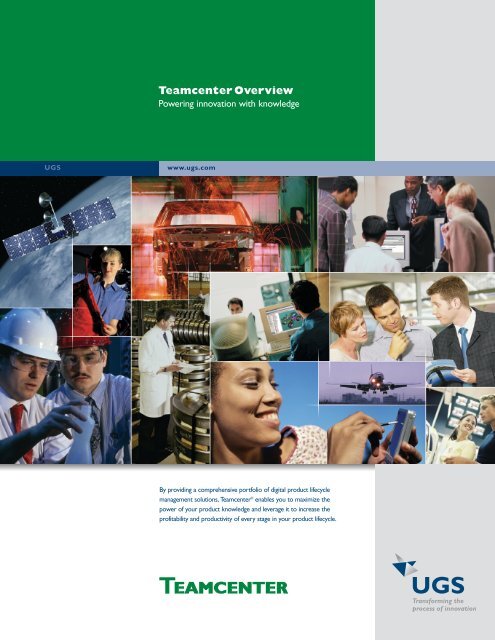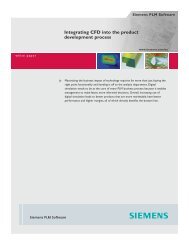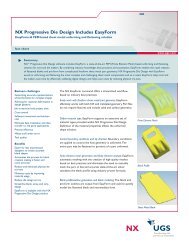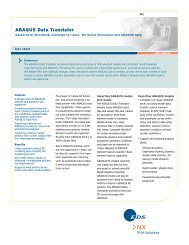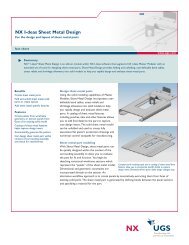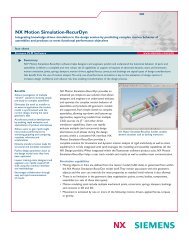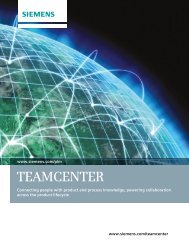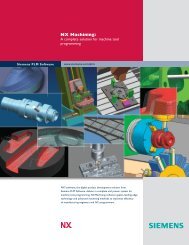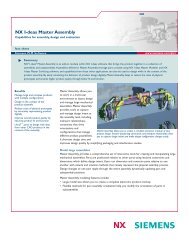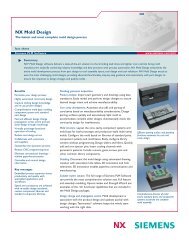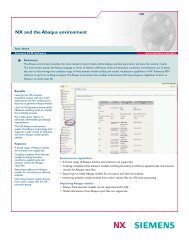teamcenter community bro**.qxd - Industrial Technology Systems, sro
teamcenter community bro**.qxd - Industrial Technology Systems, sro
teamcenter community bro**.qxd - Industrial Technology Systems, sro
Create successful ePaper yourself
Turn your PDF publications into a flip-book with our unique Google optimized e-Paper software.
Teamcenter Overview<br />
Powering innovation with knowledge<br />
UGS<br />
www.ugs.com<br />
By providing a comprehensive portfolio of digital product lifecycle<br />
management solutions, Teamcenter ® enables you to maximize the<br />
power of your product knowledge and leverage it to increase the<br />
profitability and productivity of every stage in your product lifecycle.
Business challenges<br />
In today’s digitized economy,<br />
product lifecycle management<br />
(PLM) provides your company<br />
with a unique opportunity to:<br />
Maximize your product lifecycle’s<br />
power to innovate, which<br />
translates into higher revenues,<br />
greater market share, faster<br />
take-to-market times and<br />
improved portfolio success rates.<br />
Transform the decision-making<br />
processes that you use to<br />
determine what products you<br />
should offer, how these products<br />
should be brought to market<br />
and who delivers the most<br />
business value across your<br />
entire product lifecycle.<br />
Increase the value of your product<br />
knowledge by managing this diverse<br />
intellectual capital on an enterprise<br />
basis and leveraging it across<br />
multiple programs and revenuegenerating<br />
initiatives.<br />
Minimize lifecycle cost by replacing<br />
time-consuming traditional<br />
processes with fully digitalized,<br />
accelerated solutions.<br />
To realize these opportunities<br />
and enable your product lifecycle<br />
to maximize its business value,<br />
PLM solutions need to:<br />
Facilitate competitiveness by<br />
enabling your company to establish<br />
and rigorously execute lean<br />
lifecycle processes.<br />
Improve business system<br />
interoperability by enabling every<br />
entitled participant in your product<br />
lifecycle to exchange and share<br />
their product knowledge even<br />
though this information was<br />
created under incompatible<br />
systems operating in disparate<br />
geographic, organizational and<br />
technological domains.<br />
Increase product quality by<br />
implementing systematic change<br />
controls, accommodating<br />
late-breaking configuration<br />
changes, synchronizing multiple<br />
BOMs and eliminating redundant<br />
product designs.<br />
Optimize the use of factory<br />
resources by enabling your company<br />
to link its people, plants and<br />
processes, account for design<br />
change impact on manufacturing<br />
and adopt fully effective design-for<br />
manufacturability initiatives.<br />
Improve sourcing and supply chain<br />
efficiency by eliminating delivery<br />
delays, removing collaboration<br />
barriers, reducing part proliferation<br />
and facilitating more effective<br />
data sharing.<br />
To address these challenges<br />
through product innovation and<br />
process improvement, UGS<br />
offers Teamcenter digital<br />
lifecycle management.
Introducing Teamcenter<br />
Teamcenter powers innovation and productivity by<br />
connecting people and processes with knowledge.<br />
Teamcenter’s comprehensive portfolio of proven<br />
digital lifecycle management solutions is built on an<br />
open PLM foundation. Teamcenter is the de facto<br />
standard for PLM deployments and is backed by UGS’<br />
leadership in delivery.<br />
Business solutions<br />
Teamcenter’s solutions for new product development<br />
and introduction (NPDI) and global product<br />
development link OEMs, partners and suppliers<br />
with secure, global access to product knowledge,<br />
enabling product development process excellence.<br />
Teamcenter links product development with<br />
downstream lifecycle processes by offering solutions<br />
for global manufacturing; maintenance, repair and<br />
overhaul (MRO); and strategic sourcing. By enabling<br />
consistent, repeatable processes and commonality,<br />
Teamcenter supports regulatory compliance<br />
throughout the lifecycle.<br />
With solutions targeted at critical business initiatives,<br />
Teamcenter addresses the key issues facing businesses<br />
today – accelerating time-to-market, delivering the<br />
right products to market at the right time, extending<br />
product life to maximize revenues while increasing<br />
productivity and reducing product costs. Teamcenter<br />
transcends organizational and geographic boundaries<br />
to provide people with immediate access to product<br />
knowledge, resulting in faster cycle times, better<br />
decisions, less waste and greater accountability<br />
throughout the product lifecycle.<br />
Proven delivery<br />
Teamcenter’s business solutions already include best<br />
practices and industry-specific processes, enabling your<br />
company to:<br />
• Rapidly deploy your solution<br />
• Obtain a quick return on your PLM investment<br />
• Minimize your cost of ownership<br />
• Ensure solution acceptance across your user<br />
communities<br />
In addition, UGS consultants are available to help get<br />
your Teamcenter solution up and running as quickly<br />
and cost effectively as possible. Equally important,<br />
UGS consulting services can work with you to mentor<br />
your staff in the best ways to accelerate your success<br />
in real-world, full-production settings.<br />
Teamcenter solutions target critical business initiatives<br />
New product development and introduction (NPDI)<br />
Capitalize, plan and execute innovative product ideas<br />
Regulatory compliance<br />
Manage compliance throughout the product lifecycle<br />
Global product development<br />
Design anywhere, build anywhere with global teams, suppliers<br />
and partners<br />
Strategic sourcing<br />
Collaborate with suppliers early in the product lifecycle<br />
Global manufacturing<br />
Build better products faster and more cost effectively<br />
Maintenance, repair and overhaul (MRO)<br />
Link configuration and information to operational performance<br />
1
Teamcenter’s business value<br />
Teamcenter delivers a wide range of benefits that translate directly<br />
to your company’s top-line and bottom-line business results.<br />
Accelerating time-to-market<br />
Traditionally, companies executed the product lifecycle in timeconsuming<br />
serial processes that delayed the participation of<br />
downstream contributors, such as suppliers, manufacturing experts<br />
and service/maintenance providers. By allowing your enterprise to<br />
execute as many of its lifecycle tasks as possible in parallel processes,<br />
Teamcenter enables you to streamline and collapse critical stages in<br />
your product lifecycle. Teamcenter delivers aligned, accurate and<br />
highly synchronized product knowledge to multiple disciplines<br />
early in your lifecycle – avoiding the cost and scheduling impact that<br />
comes when late suggestions<br />
and unexpected concerns<br />
arise from downstream<br />
players. Getting to market<br />
> Engineering change<br />
90 percent faster<br />
sooner ultimately means more revenue, as well as establishing<br />
an advantage over competitors who vie with you for the same<br />
market space.<br />
Maximizing top-line growth<br />
Teamcenter enables you to beat the competition to market with<br />
innovative product content that carries pricing premiums and drives<br />
early product sales. Teamcenter allows you to create, capture and share<br />
the product related expectations and preferences of your targeted<br />
customers and to align these requirements to specific design elements.<br />
As a result, your enterprise is positioned to deliver the product<br />
content that your customers<br />
want for a price they can afford<br />
at the time when it is needed.<br />
Teamcenter allows you to cost<br />
effectively deliver product<br />
> RFQ response<br />
30 percent faster with<br />
higher win ratio<br />
enhancements, derivatives, niche offerings and add-ons that extend<br />
the profitable duration of your product lifecycle. Taken together, these<br />
capabilities enable you to maximize the top-line business impact of<br />
your product lifecycle.<br />
Minimizing product and lifecycle costs<br />
Teamcenter allows you to slash cost across all of the stages in your<br />
product lifecycle – which in turn enables you to minimize the cost<br />
of the product offerings that you plan, develop, manufacture and<br />
service. For example, by leveraging<br />
Teamcenter to understand the time<br />
and resource impacts of proposed<br />
design changes and requirements<br />
changes, you can make decisions<br />
that minimize your lifecycle and<br />
product costs. By using Teamcenter<br />
to catch design flaws upfront<br />
in your lifecycle, you can avoid<br />
the cascading rework and cost<br />
associated with changing your<br />
products during the manufacturing<br />
stages of your product lifecycle.<br />
> Component selection<br />
2 to 5 percent<br />
materials savings<br />
2
By utilizing Teamcenter to incorporate the concerns of your<br />
maintenance and service groups into your product designs, you can<br />
minimize your warranty costs.<br />
By digitally creating and re-using<br />
your manufacturing plans, plant<br />
information and manufacturing<br />
processes, you can reduce your<br />
overall operational costs. By<br />
> Specification<br />
management<br />
2 to 5 percent<br />
materials savings<br />
leveraging Teamcenter to implement virtual prototyping, you<br />
can drastically reduce the validation costs associated with<br />
physical prototyping.<br />
Dramatically increasing product quality<br />
By using Teamcenter to capture quality constraints and integrate<br />
them into your product definitions, you can rigorously assess these<br />
metrics as they evolve across every stage in your product lifecycle.<br />
The automated processes that you implement under Teamcenter<br />
enable you to enforce your corporate standards and business rules<br />
on a systematic and repeatable basis. You can use Teamcenter as a<br />
collaborative venue for conducting ongoing reviews (e.g., concept<br />
studies, program reviews, design reviews, change reviews) that consider<br />
the quality concerns of all the stakeholders in your product lifecycle.<br />
You can leverage Teamcenter to rapidly conduct validation tests<br />
that ensure quality in terms of your products’ packaging, functionality<br />
usability, engineering, manufacturability and serviceability. Teamcenter<br />
lets you rigorously evaluate the quality of your products in their<br />
in-service state, as well as the quality of your service groups<br />
performance. Equally important, you can use Teamcenter to establish<br />
feedback loops (e.g., between engineering and services, as well as<br />
between engineering and manufacturing) that drive your quality<br />
programs on a cross-discipline basis.<br />
Facilitating process innovation<br />
Teamcenter enables you to establish automated processes to<br />
improve the most crucial stages in the product lifecycle. You can use<br />
Teamcenter to establish workflow rules, define user roles, configure<br />
state-specific product knowledge, launch work tasks and audit/track<br />
the execution of individual lifecycle processes. Teamcenter enables<br />
you to implement requirements-driven design – where product<br />
requirements flow through your product development process and<br />
directly influence the decisions you make regarding machine tool<br />
design, factory layout, ergonomic design, project scheduling, CAE<br />
validation and a myriad of other issues. You can accelerate your<br />
product test and verification procedures by using Teamcenter to<br />
perform repeatable digital validation. Similarly, you can leverage<br />
Teamcenter to digitally transform the planning, design, layout and<br />
execution processes in your manufacturing cycle.<br />
Increasing productivity<br />
Teamcenter provides a wide range of capabilities for improving<br />
personal and team-based productivity. Teamcenter reduces the impact<br />
of information overload by enabling users to quickly and seamlessly<br />
access widely divergent types of product, process, manufacturing and<br />
service knowledge generated by otherwise incompatible applications<br />
and authoring systems.<br />
Individual users can leverage personal viewing portals that deliver<br />
product knowledge in formats – and with levels of detail – that<br />
are attuned to the users’ everyday role, experience and comfort<br />
level. Users locate this<br />
information using web<br />
browsers while employing<br />
desktop systems, mobile<br />
laptops, personal data<br />
> Web market test<br />
2 times introduction<br />
price point<br />
assistants and wireless phones. At the group level, Teamcenter enables<br />
product teams and their suppliers to collaborate in real time, where<br />
team members access and interact with detailed product knowledge<br />
(such as 3D models, drawings and documents) while conducting<br />
virtual conferences, concept studies, program reviews, design<br />
reviews and change reviews.<br />
Maximizing information re-use<br />
Teamcenter enables you to capture information generated by diverse<br />
applications and authoring systems dispersed across your entire<br />
enterprise. Once this information is managed by Teamcenter, product<br />
teams and individual users from multiple disciplines can re-use this<br />
knowledge in multiple forms time and time again. Product teams can<br />
integrate this information into visual<br />
product models that users can access,<br />
interrogate and interactively validate.<br />
Equally important, you can use<br />
Teamcenter to re-use design elements<br />
in product derivatives that can be rapidly<br />
and inexpensively developed. Similarly, by using Teamcenter to<br />
> Document<br />
handling<br />
80 percent<br />
cost reduction<br />
facilitate systems engineering, you can define plans, processes and<br />
product definitions for an entire product platform and re-use these<br />
assets across multiple take-to-market programs.<br />
3
The Teamcenter advantage<br />
Teamcenter advantage<br />
De facto standard<br />
for PLM deployments<br />
Comprehensive portfolio<br />
of lifecycle solutions<br />
Leadership in delivery<br />
Open PLM foundation<br />
Why it matters<br />
Teamcenter is the world’s market-leading platform for delivering PLM. Its marketplace success ensures your<br />
company that the promise of PLM and the ability to deliver proven results has been validated in real-world,<br />
full-production solutions. The most successful companies in the world have chosen – and deployed –<br />
Teamcenter as a mission-critical system because:<br />
• Teamcenter delivers unsurpassed PLM technology<br />
• Companies that adopt Teamcenter are already experiencing substantial top-line and bottom-line business results<br />
• Teamcenter’s scalable architecture enables companies to adopt PLM at their own company-specific pace<br />
• Teamcenter’s comprehensive functional capabilities are augmented by a full line of services and ancillary products<br />
Teamcenter delivers a portfolio of applications that – combined together – integrates your product lifecycle<br />
phases, participants and product knowledge into a collaborative environment that you can leverage to solve<br />
multiple business problems. Teamcenter solutions link users with secure, global access to product<br />
knowledge, enabling process excellence throughout the lifecycle.<br />
Teamcenter process-oriented solutions:<br />
• Teamcenter for Engineering Process Management<br />
• Teamcenter for Enterprise Knowledge Management<br />
• Teamcenter for Lifecycle Visualization<br />
• Teamcenter for Community Collaboration<br />
• Teamcenter for <strong>Systems</strong> Engineering<br />
• Teamcenter for Compliance Management<br />
• Teamcenter for Program and Project Management<br />
• Teamcenter for Strategic Sourcing<br />
• Teamcenter for Digital Manufacturing<br />
• Teamcenter for Maintenance, Repair and Overhaul (MRO)<br />
These solutions provide your PLM environment with:<br />
• Visibility to product knowledge that is configured to individual lifecycle phases<br />
• Process management capabilities that pertain to specific lifecycle phases<br />
• Visualization and collaboration capabilities that enable lifecycle participants to seamlessly leverage design<br />
content without having to understand or install an authoring application<br />
Teamcenter is backed by UGS’ leadership in delivery. UGS has deployed Teamcenter solutions to more than<br />
2 million users worldwide, the largest customer base for any PLM offering. UGS offers industry-specific<br />
solutions and best practice templates that deliver a rapid return on your Teamcenter investment.<br />
Teamcenter solutions are delivered on an open PLM foundation that future-proofs your company’s investment<br />
and facilitates vendor independence. Teamcenter’s open foundation leverages widely accepted standards,<br />
including Java 2 Enterprise Edition, Microsoft .NET Framework, UDDI, XML, SOAP, JSP technology and the<br />
JT file format. Teamcenter’s service-oriented architecture is scalable to meet the needs of small to large<br />
deployments. This open foundation allows Teamcenter to integrate your mission-critical ERP, CRM, and SCM<br />
investments into your PLM environment, as well as rapidly accommodate new suppliers, partners, customers<br />
and other lifecycle participants.<br />
4
Teamcenter for engineering process management<br />
Teamcenter enables product teams to capture knowledge created from<br />
multiple sources and integrate this information into product definitions<br />
that you can leverage in automated release, design management,<br />
engineering process management, digital validation, engineering change<br />
and team collaboration processes.<br />
Teamcenter lets your engineering teams capture works in progress<br />
and release data authored under a variety of industry-leading CAD<br />
systems – including NX , I-deas ® NX Series, Solid Edge ® , AutoCAD,<br />
Catia V4 and V5, Pro/Engineer, SolidWorks and Autodesk Inventor –<br />
and manage this information in a global environment that facilitates<br />
multi-site product development. Teamcenter can integrate all of a<br />
product’s parts into seamless product definitions that you can<br />
track and assess as they evolve from one phase in your product<br />
lifecycle to another.<br />
To extend Teamcenter’s engineering process management capabilities<br />
to non-CAD users, Teamcenter integrates visualization capabilities<br />
that leverage CAD-neutral 3D visualization (JT file format). Extended<br />
product teams can compare components and assemblies and identify<br />
engineering changes authored under multiple CAD tools.<br />
Teamcenter offers a scalable building block solution that ranges<br />
from basic to comprehensive engineering process management.<br />
The scalability of the Teamcenter solution enables customers to<br />
implement the technology in phases.<br />
Teamcenter Express is an easy-to-use, preconfigured and easy-todeploy<br />
collaborative product development management (cPDM)<br />
solution designed to meet the requirements of mid-sized manufacturing<br />
companies. Teamcenter Express’ task and process management is an<br />
entry point into the powerful Teamcenter portfolio.<br />
Teamcenter Express provides the collaborative design management<br />
functionality that your engineering teams need to manage design data<br />
and communicate both internally and externally to your organization.<br />
Teamcenter Express helps mid-sized manufacturing companies to<br />
automate their business processes by applying preconfigured best<br />
practices to everyday engineering tasks.<br />
Teamcenter Engineering is a full engineering process management<br />
solution for companies that want to implement comprehensive change<br />
and validation management, enable requirements to be visible during<br />
the design process, integrate supplier collaboration, integrate sourcing<br />
into the design process, manage complexity and make manufacturing<br />
decisions during the design cycle.<br />
Teamcenter Engineering’s change and validation management<br />
addresses one of the biggest challenges to increasing productivity<br />
and eliminating errors and cost overruns – the efficiency of the change<br />
process. Designers must be able to analyze changes quickly in the<br />
context of other changes and assess the impact of the change on<br />
the complete product.<br />
Teamcenter Engineering’s change management capabilities allow a<br />
company to manage product changes, synchronize those product<br />
changes with bill of material changes, and communicate the result<br />
across the entire extended enterprise. When components are replaced<br />
in the product’s structure, Teamcenter Engineering provides a graphical,<br />
interactive presentation of the replacement history.<br />
To manage the complexity of their product offerings and facilitate<br />
greater product variety, companies must organize their product<br />
architecture into platforms and modules. Key in this approach is the<br />
sharing of components, modules and other assets across product<br />
families. Teamcenter Engineering’s powerful option and variant<br />
management capabilities allow you to improve commonality by enabling<br />
you to organize your product architecture into platforms and modules<br />
Validation teams also can leverage Teamcenter Engineering’s “alwayson”<br />
digital prototyping capabilities, called repeatable digital validation<br />
(RDV), to allow engineers to evaluate their work against all other<br />
changes and all configurations continuously. .<br />
Teamcenter Engineering’s connectivity to requirements management<br />
enables customers to continually validate their designs against product<br />
specifications and compliance requirements. Teamcenter Engineering’s<br />
connectivity to <strong>community</strong> collaboration extends product collaboration<br />
to suppliers. Customers can easily drag and drop product information,<br />
design specifications, manufacturing information and other related<br />
documents from their managed environment into project collaboration<br />
folders for suppliers to access, review and conduct synchronous<br />
collaboration. The marked-up documents can be saved in the managed<br />
environment for warranty issues, reporting change history and<br />
lessons learned.<br />
5
Teamcenter for enterprise knowledge management<br />
Teamcenter Enterprise enables companies to extend their<br />
knowledge management and process automation capabilities on an<br />
enterprise basis. Using Teamcenter, companies assemble an array<br />
of knowledge that an entire enterprise can leverage to implement<br />
its decision support and process automation initiatives.<br />
By allowing you to capture, integrate, secure and control all of<br />
your product, process, manufacturing and service knowledge in<br />
a single PLM environment, Teamcenter Enterprise provides a body<br />
of information that lifecycle participants can subsequently use<br />
to synchronize their product assumptions, collaborate with each<br />
other, make on-the-mark business decisions and incorporate<br />
aligned information into lifecycle processes that apply to every<br />
phase in your product lifecycle. For example:<br />
• Teamcenter Enterprise’s application-specific integrations enable<br />
information authors to leverage their authoring system of choice<br />
(e.g., MCAD, ECAD, CAE, CAM, CASE, word processing and<br />
document management systems) to create product-related works<br />
in progress. Once this information is ready to be<br />
shared/exchanged on an enterprise basis, authors can use these<br />
integrations to capture this knowledge in Teamcenter Enterprise.<br />
• Teamcenter Enterprise’s vaulting, versioning control, checkin/check-out<br />
and security protection capabilities enable your<br />
enterprise to manage and control this aggregate knowledge in<br />
Teamcenter’s global repository.<br />
• Teamcenter Enterprise’s product structure, configuration<br />
management and visualization capabilities enable you to integrate<br />
information generated by multiple applications and create higherlevel<br />
product representations (such as product models, product<br />
definitions, product configurations and virtual prototypes).<br />
• Teamcenter Enterprise’s integrated visualization and collaboration<br />
capabilities enable widely dispersed product team members to<br />
view, mark up and exchange these higher-level product<br />
representations.<br />
• Teamcenter’s process management capabilities enable product<br />
teams to define automated processes with repeatable rules, user<br />
roles and workflow definitions that your enterprise can re-use<br />
and execute across multiple take-to-market programs.<br />
Teamcenter Enterprise also supports your PLM initiatives by<br />
facilitating change management, parts classification, release<br />
management, option and variant management, event notification,<br />
relationship management and process innovations.<br />
6
Teamcenter for compliance management<br />
Teamcenter’s enterprise knowledge and process management<br />
empowers employees to support compliance in their daily tasks.<br />
Teamcenter supports compliance management in a general sense by:<br />
1) capturing regulatory requirements early in the product lifecycle and<br />
integrating those requirements into the product definition as it evolves;<br />
2) providing the process visibility and integrity to empower employees<br />
to respond to regulatory issues; and 3) providing access to the right<br />
product information at the right time.<br />
Teamcenter for Compliance Management solutions offer the<br />
following benefits:<br />
• Facilitate design-for-compliance initiatives<br />
• Provide product developers with rapid visibility to all compliant<br />
and noncompliant components<br />
• Integrate compliance management capabilities into current<br />
business processes<br />
• Minimize risk of noncompliance<br />
• Reduce total cost of ownership<br />
• Minimize cost associated with excess and obsolete inventory<br />
otherwise caused by the use of noncompliant parts<br />
With its robust knowledge management framework for configuration<br />
management, record keeping and audit tracking, Teamcenter supports<br />
compliance mandates in a general sense, and also offers specific<br />
solutions for compliance:<br />
Environmental compliance<br />
To address overall compliance objectives while enabling product makers<br />
to specifically comply with the End-of-Life Vehicle (ELV), Restriction on<br />
the Use of Hazardous Substance (RoHS) and Waste from Electrical and<br />
Electronic Equipment (WEEE) directives, UGS offers Teamcenter’s<br />
Environmental Compliance solution for the end-to-end collection,<br />
management and reporting of environmental compliance and material<br />
content information.<br />
Medical compliance<br />
To specifically comply with requirements for the medical devices<br />
industry, UGS offers Teamcenter’s Medical Compliance solution.<br />
The Teamcenter solution allows customers to manage digital product<br />
information across the lifecycle in accordance with regulatory<br />
requirements such as those established by the U.S. Food and Drug<br />
Administration (FDA). Teamcenter provides improved reliability and<br />
enhanced product quality at reduced costs, while at the same time<br />
fulfilling FDA requirements for new product introduction.<br />
Export control<br />
In this digital age, governments around the world are concerned<br />
about controlling the export of information. For example, the U.S.<br />
International Traffic in Arms Regulations (ITAR) governs the sharing of<br />
technical information between U.S. companies and foreign nationals,<br />
regardless of where that access occurs (whether in the U.S. or abroad).<br />
These regulations hold companies accountable for the acts of anyone<br />
in their employ who shares technical data. Penalties for export<br />
violations can be severe – $1M and 10 years in prison per violation,<br />
prohibitions against future exports by the company and the loss<br />
of government contracts.Teamcenter’s Authorized Data Access<br />
solution integrates export control-specific security measures at the<br />
program level within Teamcenter’s knowledge management and<br />
collaboration environment.<br />
Document and records management<br />
The standardization of document and records management policies<br />
and procedures ensures that appropriate protection is given to all<br />
records and that the evidence and information they contain can<br />
be retrieved more efficiently and effectively, using standards and<br />
procedures. Document and records management is a challenge for<br />
both commercial and government sectors worldwide.<br />
Within the U.S., there are specific standards that have been established<br />
for document and records management. For example, the U.S.<br />
Department of Defense’s 5015.2 standard provides implementing and<br />
procedural guidance for the management of records in the DoD. The<br />
Sarbanes-Oxley Act of 2002 provides a second example with the most<br />
significant act of the U.S. Congress to bring changes to corporate<br />
governance, putting compliance issues at the forefront for U.S. public<br />
companies. Similar legislation is being enacted by other governments<br />
around the world.<br />
Teamcenter’s document and records management capabilities help meet<br />
the DoD 5015.2 and Sarbanes-Oxley (SOX) requirements, along with<br />
other mandates, with document management and workflow capabilities<br />
that enable compliance.<br />
7
Teamcenter for lifecycle visualization<br />
Teamcenter Visualization provides the Teamcenter environment<br />
with a family of visualization solutions that product teams can use<br />
to visualize a whole product and enable all of the participants in<br />
the product lifecycle to interact directly with its design data.<br />
By enabling lifecycle participants to visualize and leverage product<br />
data in 2D and 3D formats even when this data is created using<br />
different authoring software, Teamcenter Visualization:<br />
• Allows extended lifecycle participants (such as sales and marketing<br />
organizations, allied partners, suppliers and trusted customers)<br />
to take part in the concept design process early and often<br />
without incurring the cost, complexity or training associated<br />
with CAD systems<br />
• Facilitates more fully informed lifecycle decisions by allowing<br />
product teams to exchange, share and mark up universally<br />
accessible visualizations that represent the product in its entirety<br />
• Streamlines innovation by enabling product teams to visualize<br />
new product ideas, test their validity and evaluate alternative<br />
design concepts collaboratively by utilizing virtual prototypes<br />
Teamcenter Visualization enables your enterprise to match its<br />
company-specific needs with the following scalable service levels:<br />
Teamcenter Visualization Base delivers full-function 2D capabilities,<br />
including extensive 2D markup and investigation tools, as well<br />
as measurement and comparison capabilities and basic 3D<br />
visualization functionality.<br />
Teamcenter Visualization Standard provides enterprise 2D/3D review<br />
and markup capabilities for advanced 3D visualization,<br />
powerful 3D markup and access to advanced<br />
product data, including product structure and<br />
product and manufacturing information (PMI).<br />
Teamcenter Visualization Professional delivers full-function<br />
collaborative design review tools, such as 2D/3D analysis<br />
capabilities for 3D investigation, including measurement, dynamic<br />
cross sectioning, comparison and user-defined coordinate system<br />
capabilities for analyzing multi-CAD assemblies.<br />
Teamcenter Visualization Mockup provides sophisticated digital<br />
mockup capabilities that design teams can use to assemble a<br />
complete digital prototype, perform advanced analysis – including<br />
static and dynamic clearance analysis on the whole product – and<br />
detect issues early in the product lifecycle.<br />
iSeries delivers an easy to deploy and maintain web browser-based<br />
implementation of the Teamcenter Visualization Base, Standard and<br />
Professional service levels.<br />
Teamcenter Visualization offers a host of advanced, process-oriented<br />
add-ons, such as Concept for immersive digital mockup, Publishing for<br />
technical publishing, Jack for ergonomic validation, VSA for tolerance<br />
simulation, Quality for production quality validation, ClearanceDB for<br />
automatic clearance/interference management and Path Planning for<br />
assembly validation.<br />
Teamcenter Visualization has proven its credentials as the world’s<br />
leading visualization standard for more than a decade by delivering<br />
unmatched performance and a solution portfolio of unsurpassed<br />
breadth. Teamcenter Visualization has generated substantial returns<br />
on investment for more than 600,000 users in more than 35,000<br />
sites across 43 countries.<br />
Teamcenter Visualization is powered by JT technology – a highly<br />
flexible CAD-neutral format that can be created from all major<br />
CAD applications, allowing full representation of relevant model<br />
information. Because Teamcenter Visualization solutions utilize the<br />
JT file format, product teams are able to<br />
visualize extremely large assemblies and<br />
validate design details in the context of a<br />
complete assembly. CAD users often employ<br />
Teamcenter Visualization for large assembly<br />
viewing because their native CAD system<br />
cannot handle this amount of data.<br />
8
Teamcenter for <strong>community</strong> collaboration<br />
Teamcenter Community provides enterprises with a secure,<br />
adaptive and IT friendly Microsoft-based environment that product<br />
teams can use to visually collaborate across every phase in the<br />
product lifecycle – without having to incur any special training or<br />
learn how to use a PLM or CAD system.<br />
Teamcenter Community enables product teams to work with their<br />
suppliers, allied partners and trusted customers in a real-time<br />
environment that facilitates the rapid formation of sourcing teams,<br />
concept studies, program reviews, design reviews and engineering<br />
change processes. To support these initiatives, Teamcenter<br />
Community enables product teams to:<br />
• Quickly invite individual team members to join a virtual team<br />
• Establish virtual conference rooms where team members can<br />
engage in managed collaborative processes<br />
• Easily capture ad hoc product knowledge that is generated<br />
informally (i.e., unstructured information that resides in emails,<br />
individual desktops and team members’ minds)<br />
• Integrate this unstructured knowledge with the structured knowledge<br />
already managed by Teamcenter<br />
• Share/exchange both structured and unstructured knowledge in<br />
a single environment that facilitates visual product collaboration<br />
while eliminating the time-consuming tasks normally involved<br />
when working with multi-CAD projects<br />
• Provide individual team members with personal portal views<br />
that match their user roles, workflow responsibilities and<br />
security entitlements<br />
• Enable team members to leverage a wide range of visual<br />
collaboration tools, including 3D product visualizations, instant<br />
messaging, digital calendars and digital schedules<br />
In essence, Teamcenter Community enables team members to<br />
integrate their existing desktops into a collaborative environment<br />
that combines the robust advantages of PLM with the familiarity<br />
and ease-of-use associated with Microsoft’s desktop environment.<br />
Because Teamcenter Community is based on Microsoft Office<br />
and is designed to plug into your web-based business environment,<br />
you can leverage the knowledge retained in your legacy ERP,<br />
SCM and CRM systems alongside the product knowledge<br />
managed by Teamcenter.<br />
9
Teamcenter for <strong>Systems</strong> Engineering<br />
Teamcenter for <strong>Systems</strong> Engineering provides solutions that enterprises<br />
can use to improve the product development cycle in its entirety. By<br />
allowing your enterprise to understand its products from a holistic<br />
perspective, Teamcenter for <strong>Systems</strong> Engineering enables product teams<br />
to optimize the tradeoffs made at multiple stages in a decision-intensive<br />
product lifecycle.<br />
By leveraging Teamcenter for <strong>Systems</strong> Engineering, your enterprise can:<br />
• Maximize the revenue generating potential of your products by<br />
ensuring that you deliver the right product content at the right time<br />
to the right target market<br />
• Understand the customer requirements, program constraints and<br />
design elements that pertain to your whole product offering – and<br />
thereby mitigate the risk and minimize the cost associated with<br />
product development<br />
• Effectively assess the cost and scheduling impacts associated with<br />
proposed design/requirement changes<br />
• Optimize your products on an interdisciplinary basis by simultaneously<br />
improving multiple product attributes, including performance, cost<br />
effectiveness, quality and reliability<br />
Teamcenter for System Engineering’s web-based requirements<br />
management, group collaboration and information-linking capabilities<br />
facilitate a team-based approach to product development that<br />
enables team members to communicate within the context of the<br />
whole product.<br />
Teamcenter’s requirements management capabilities allow your<br />
enterprise to define, capture, engineer, manage and leverage product<br />
requirements and compliance regulations on a repeatable and rigorous<br />
basis. You can incorporate these requirements directly into your<br />
Teamcenter-driven validation processes, thereby ensuring that your<br />
product offerings will meet the customer expectations, quality goals<br />
and government standards defined by their specific market space.<br />
• Teamcenter enables you to understand what your target markets<br />
and customer base want in terms of documented expectations,<br />
preferences, standards and regulations that you capture from<br />
diverse sources as product requirements.<br />
• Teamcenter lets you supplement these requirements with quantifiable<br />
constraints that determine the success of your product programs in<br />
terms of their cost and delivery schedules, as well as their ability to<br />
satisfy established performance, ergonomic, safety, usability, reliability,<br />
maintainability, recycling/disposal and other compliance-related metrics.<br />
• Teamcenter enables you to connect these requirements and constraints<br />
into fine-grain design elements that you can trace across the configurations<br />
and product definitions that describe a product’s various lifecycle states.<br />
• Teamcenter facilitates cross-discipline closed-loop feedback by recognizing<br />
when your program constraints are in danger of being violated, when<br />
changes to your product requirements and design elements occur and<br />
when review teams need to understand the requirements-related<br />
impact of proposed design changes.<br />
Teamcenter’s patented connected requirements capabilities let you link<br />
regulations (such as the Congressional Battery Act and EEU Directives)<br />
into your product design process – thereby enabling you to “build in”<br />
regulatory compliance across your entire product lifecycle. Similarly,<br />
Teamcenter enables you to connect Six Sigma goals into your upstream<br />
processes in your product lifecycle and facilitate Design for Six Sigma.<br />
Teamcenter for <strong>Systems</strong> Engineering enables product teams<br />
to create a wide variety of high-level system views called<br />
hierarchies. Users establish hierarchies to represent multiple<br />
product views, including product structures, organizational<br />
assignments, manufacturing views, project management<br />
perspectives, cost analyses, and documentation views.<br />
Once these views are captured, they can be interrelated<br />
to provide your enterprise with total visibility to a whole<br />
product, as well as to optimize the product’s interdependent<br />
program constraints by subjecting them to tradeoff analyses<br />
before detailed design begins.<br />
10
Teamcenter for program and project management<br />
Teamcenter Project provides a web-native e-business application<br />
that product teams can leverage to plan and manage lifecycle<br />
projects on a real-time basis. Teamcenter Project is distinguished<br />
by its ability to allow cross-discipline teams to create and share<br />
project information in a real-time environment that facilitates<br />
simultaneous project viewing and instantaneous updating.<br />
Teamcenter Project enables teams to create, maintain and monitor<br />
project schedules that reflect fine-grain work tasks, dependencies,<br />
milestones and start/finish dates. Team members can monitor<br />
these schedules in real time by interactively accessing Gantt charts<br />
that can be edited on a collaborative basis. Teamcenter Project<br />
supports a variety of powerful scheduling features including the<br />
ability to define an unlimited number of task hierarchies, establish<br />
project baselines, manage effort-driven schedules and identify<br />
task constraints.<br />
Teams can leverage Teamcenter Project’s resource management<br />
and organizational breakdown capabilities. Teams can define each<br />
project in terms of its work tasks, related costs, the resources<br />
required to execute each task and the skill sets needed by the<br />
resource in question. Teams can assign tasks to specific individuals<br />
on a multi-project basis. They also can monitor project status in real<br />
time (e.g., by generating interactive histograms that highlight overutilized<br />
and under-utilized resources). In addition, team members<br />
can receive assignments and update their progress on specific tasks<br />
across multiple schedules – at anytime from anywhere.<br />
Teamcenter Project’s collaborative cost management capabilities<br />
enable teams to associate bill rates with resources or skill sets and<br />
provide managers with both detailed and summary project costs –<br />
including estimated and accrued costs. Teamcenter Project can<br />
reflect both variable labor and fixed costs, as well as leverage its<br />
timecard reporting capabilities to allow team members to submit<br />
project-based timecards for online management approval.<br />
Teamcenter Project’s extensive tracking and reporting capabilities<br />
provide executives with summary updates that highlight the status<br />
of all teams and projects. It also provides event-based notices to<br />
warn executives about emerging trouble spots. Email and pop-up<br />
notifications can be generated to describe events that influence<br />
schedules, costs, documents and ongoing team discussions.<br />
In addition, Teamcenter Project produces “big picture” views<br />
that cross multiple schedules and allow managers to view this<br />
information in easy-to-read Gantt format.<br />
Because Teamcenter Project is integrated with Teamcenter’s<br />
knowledge management and collaboration capabilities, your<br />
enterprise can create, capture, manage and leverage its project<br />
knowledge in the same PLM environment you use to manage<br />
the rest of your product, process, manufacturing and service<br />
knowledge. As a result, your project knowledge is able to<br />
directly contribute to all of the business initiatives you adopt<br />
to digitally transform your product lifecycle.<br />
11
Teamcenter for strategic sourcing<br />
Teamcenter Sourcing provides a new approach to strategic sourcing that<br />
ties e-sourcing, knowledge management and collaboration capabilities<br />
together to provide all of the stakeholders in your supply chain with a<br />
single point of access to your sourcing and product data. Once these<br />
process improvements are in place, you can turn your supply chain into<br />
a fully functioning innovation chain that:<br />
• Increases sourcing productivity by reducing the time your<br />
enterprise spends on tactical sourcing and increasing the time<br />
available for performing strategic sourcing analysis<br />
• Improves RFP, RFI and RFQ response times by integrating your<br />
product BOM and sourcing data into a single window that<br />
facilitates automatic bid package preparation while allowing your<br />
procurement teams to more rapidly evaluate supplier bids<br />
• Facilitates real time collaboration by enabling suppliers to<br />
participate in your design and change processes sooner and<br />
contribute more effectively to your cost reduction and<br />
innovation initiatives<br />
Teamcenter Sourcing delivers online sourcing solutions for:<br />
• RFPs and sourcing surveys. Teamcenter Sourcing supports automatic<br />
distribution of an RFP or survey, easy online questionnaire<br />
completion, automated supplier communications and improved<br />
response analysis.<br />
• Spend management. Teamcenter Sourcing tracks spending and<br />
compliance across your enterprise by business unit, supplier,<br />
commodity and diversity supplier classification – enabling you to<br />
leverage purchasing power and allow procurement professionals<br />
to quickly target sourcing opportunities.<br />
• Auctions. Teamcenter Sourcing enables procurement teams to<br />
bring the negotiation process online with total cost functionality<br />
that allows bidding on price and non-price components, resulting<br />
in reduced sourcing cycle times, true price transparency and<br />
tremendous cost savings.<br />
• Sourcing Community template (built with Teamcenter Community<br />
and sourcing best practices from A.T. Kearney, a UGS strategic<br />
partner). Teamcenter Sourcing provides sourcing teams with a<br />
collaborative workbench to capture all of the knowledge and<br />
information gained during a sourcing effort. The sourcing <strong>community</strong><br />
delivers enterprise collaboration tools that enable you to “market”<br />
your deals and educate your employees on new agreements<br />
in a consistent manner particularly appropriate for large and<br />
decentralized organizations. Your sourcing <strong>community</strong> functions<br />
in a collaboration environment that is based on the Microsoft<br />
platform. This environment extends the reach of your user<br />
desktops through a common Windows- and Office-based<br />
foundation and Microsoft SharePoint Services.<br />
By extending these sourcing applications with Teamcenter’s<br />
enterprise knowledge management and collaboration capabilities,<br />
you can closely align your procurement process with your<br />
engineering processes so that:<br />
• Suppliers can fully understand your product requirements, supply<br />
chain needs and product definitions.<br />
• Development teams can assess each prospective supplier in terms<br />
of its design content, cost efficiencies and product quality, as well<br />
as the supplier’s capabilities and overall quality.<br />
12
Teamcenter for digital manufacturing<br />
To support your company’s transition from the physical factory<br />
to the digital factory, Teamcenter Manufacturing delivers a digital<br />
manufacturing backbone that establishes the relationships and<br />
associations among your product, process, plant and resource<br />
knowledge – enabling you to leverage this combined knowledge<br />
to create, manage and maintain a comprehensive plan for producing<br />
your products.<br />
Teamcenter Manufacturing bridges the gap between product<br />
development and the factory floor by managing the product,<br />
process, plant and resource knowledge that your manufacturing<br />
engineers can use to perform:<br />
• Part manufacturing planning<br />
• Assembly process planning<br />
• Resource management<br />
• Plan design and optimization<br />
• Ergonomics and human performance<br />
• Product quality planning<br />
• Production execution<br />
In essence, Teamcenter Manufacturing allows you to leverage<br />
upstream product lifecycle information (such as the product<br />
definitions that evolve from your CAD/CAM/CAE systems)<br />
and feed them into your downstream manufacturing planning<br />
and execution systems (e.g., your ERP/MES solutions).<br />
Teamcenter’s ability to integrate and leverage these otherwise<br />
dissimilar information silos enables your enterprise to quickly<br />
assess how individual lifecycle decisions will impact specific<br />
product, process, plant and resource plans.<br />
By some industry estimates, manufacturing engineers spend nearly<br />
half their time searching for information they need to perform their<br />
jobs. Teamcenter Manufacturing enables you to deliver critical<br />
manufacturing planning information to all of your enterprise’s<br />
entitled lifecycle participants on demand. As a result, your product<br />
and manufacturing teams can rapidly assess the impact of specific<br />
lifecycle decisions. For example, if a design team proposes a<br />
product revision or if a manufacturing team proposes a change to<br />
a factory layout, Teamcenter Manufacturing can instantly determine<br />
and deliver the corresponding impacts on your product, process,<br />
plant and resource plans.<br />
13
Teamcenter for Maintenance, Repair and Overhaul (MRO)<br />
Teamcenter for MRO provides a suite of solutions that enable<br />
enterprises to digitally transform the processes associated with<br />
maintaining, repairing and overhauling their complex operational<br />
assets. By using a configuration-driven approach to managing<br />
operational product knowledge, the Teamcenter for MRO solution<br />
suite addresses the business needs of OEMs/prime contractors,<br />
owners/operators and third-party service providers who require:<br />
• Configuration management – to capture, link and manage<br />
full configurations of operational assets in their as-designed<br />
(as-engineered), as-built and as-maintained (as-serviced)<br />
lifecycle states. Teamcenter for MRO manages all related<br />
operational knowledge within the context of an appropriate<br />
configuration phase, including tech orders and service<br />
manuals, service bulletins, inspection reports, deviations<br />
and waivers, 2D drawings, 3D illustrations and animations<br />
of procedures and valid configurations with alternates<br />
and substitutes.<br />
• Maintenance planning – to establish requirements, define<br />
service resources, optimize service visits, roll up maintenance<br />
requirements across an asset base, forecast MRO requirements,<br />
account for unscheduled maintenance and analyze individual<br />
assets in terms of their operational life-limits and utilization.<br />
• Maintenance execution – to assign and distribute work orders by<br />
zone, process and skill set and to support audit and compliance<br />
verification. Teamcenter for MRO is particularly adept at capturing<br />
work execution and metrics for the life limited parts, deviations,<br />
discrepancies and deferred defects.<br />
• Material management – to capture and manage parts, tools and<br />
equipment inventory and track their related life-limits, shelf life,<br />
part status, dispositions, usage rates and history. Teamcenter for<br />
MRO also tracks outsourced work and facilitates inventory<br />
distribution, vendor management, warranty management and<br />
compliance record management.<br />
Teamcenter for MRO allows enterprises to plan and deliver<br />
MRO services more effectively, maximize the operational availability<br />
of managed capital assets and ensure compliance with servicerelated<br />
metrics. By facilitating total asset visibility across the full<br />
and useful life of an operational asset, Teamcenter for MRO enables<br />
enterprises to increase asset readiness and reliability, reduce<br />
turnaround time, improve product performance and reliability<br />
and optimize service financial models.<br />
By providing accurate and up-to-date product and process<br />
knowledge at the service team’s point of need, Teamcenter for<br />
MRO allows service organizations to maximize their response times<br />
and significantly improve “wrench time” productivity. Teamcenter<br />
for MRO delivers a true configuration of a product before and<br />
during service depot events – thereby facilitating maintenance<br />
planning, improved service quality and faster, more cost effective<br />
event resolution.<br />
Teamcenter for MRO enables you to capture the service experience<br />
for feedback so that you can drive ongoing engineering and service<br />
improvement programs. Since Teamcenter for MRO works within<br />
an overall PLM solution, enterprises benefit from integrated change<br />
management, configuration management and other improvement<br />
processes over the asset’s entire lifecycle.<br />
14
PLM checklist<br />
PLM functionality<br />
Application integration<br />
Teamcenter capability<br />
Teamcenter enables authors to rapidly capture information from their application system of<br />
choice in several ways.<br />
Teamcenter’s full range of out-of-the-box application integrations automatically register data files in<br />
Teamcenter when application authors create this data. Teamcenter retains highly accurate database paths<br />
that note the physical residence of the application data – ensuring that Teamcenter is directly updated<br />
whenever a data change is made. Teamcenter also retains metadata (e.g., attributes of the data files being<br />
registered) to facilitate subsequent information search and retrieval.<br />
Teamcenter enables application authors to establish standards-based enterprise application integrations<br />
that interrogate the PLM environment and its connected ERP, SCM and CRM systems, draw unified<br />
information from these systems and either present this information to requesting users or exchange<br />
information between the connected applications in response to product-related changes/events.<br />
Teamcenter’s open foundation leverages widely accepted standards, including Java 2 Enterprise Edition,<br />
Microsoft .NET Framework, UDDI, XML SOAP, JSP technology and the JT file format.<br />
Information access/retrieval<br />
Information security<br />
Product definition<br />
Teamcenter supports universal search by enabling knowledge users to employ conventional web browsers<br />
to query the PLM environment for information created under multiple authoring systems. Users can<br />
conduct their searches by specifying attributes (metadata), as well as performing full text searches. Users<br />
can employ graphical product structures to quickly navigate through the parts/components that comprise<br />
a product configuration.<br />
Teamcenter’s universal viewing capabilities allow users to view all of the PLM environment’s content using any<br />
web browser at any time from anywhere. Teamcenter enables users to view this content in its native format<br />
or in standard distribution/viewing formats (such as JT files or pdfs).<br />
Teamcenter retains the paths and metadata that pertain to the PLM environment’s managed information<br />
in a database repository that can be controlled, accessed, audited and shared on an enterprise basis. The<br />
repository enables the enterprise to share its product knowledge in a distributed or federated multi-site<br />
environment. A variety of Teamcenter capabilities control and protect this product knowledge, including:<br />
Check-in/check-out – protects the integrity of your product knowledge by locking out works-in-progress.<br />
Revisioning/versioning – manages information changes by enabling you to track and audit revisions and<br />
intermediate versions.<br />
System and data security – protect the PLM environment’s underlying systems and databases from unauthorized<br />
access/use, as well as defining how individual pieces of product information (objects) can be used. Teamcenter<br />
supports the standard HTTPS protocol to protect the delivery of web-based information across firewall<br />
boundaries. Teamcenter controls user access on the basis of security clearances and entitlements that pertain<br />
to individual users, user roles, teams, groups and projects.<br />
Teamcenter enables lifecycle participants to work in a product-centric framework that aligns the enterprise’s<br />
users, information and processes around a series of interrelated product, process, manufacturing and service<br />
definitions. To support this framework, Teamcenter provides:<br />
Product structure management – enables product developers to establish/leverage a hierarchical tree<br />
structure that represents the entire product in terms of its parts, subassemblies and assemblies and the<br />
information objects that define them.<br />
Configuration management – enables lifecycle participants to identify, control, assess and audit the<br />
configurations that evolve across the entire product lifecycle (i.e., the product’s as-required, as-designed,<br />
as-planned, as-built and as-maintained lifecycle states).<br />
15
Option/variant management – enables developers to create a generic product structure for an overarching<br />
product platform (i.e., that supports the development of multiple product programs, including the<br />
development of entire product families, derivatives, variants, options, add-ons and niche offerings).<br />
Parts classification – enables product developers to organize and classify all of the parts that comprise the<br />
product definition so that they can be easily accessed and re-used for multiple development programs.<br />
Process management<br />
Document management<br />
Product change management<br />
Multi-CAD product<br />
development<br />
Teamcenter provides a robust set of workflow capabilities that an enterprise can use to automate its<br />
lifecycle processes, including:<br />
Rule definitions – defines the company-specific business rules that determine how and under what conditions<br />
information is to be made available to the enterprise and its user communities<br />
User roles – determines who is entitled to receive specific kinds of information on the basis of their<br />
lifecycle responsibility<br />
Notification services – automatically notifies entitled users when changes are made to specific information objects<br />
Teamcenter enables enterprises to identify, manage, access and re-use all of the documents that pertain to the<br />
product lifecycle by supporting a complete set of authoring, knowledge user and workflow capabilities, including:<br />
Online enterprise publishing. Enterprises can “publish” documents (created across their PLM environment)<br />
in Teamcenter and tie these documents to a product’s related parts and components – as well as to various<br />
product configurations and their related BOMs. Universally accessible documents (such as pdfs) can be<br />
rapidly spun off, viewed and printed from Teamcenter’s single source of product knowledge.<br />
Authoring tool interface. Document authors can work with Teamcenter through seamless application interfaces<br />
to Microsoft Word, PowerPoint and Excel.<br />
On-demand viewing. Knowledge users can employ web browsers to find documents managed by Teamcenter.<br />
Users query Teamcenter by conducting full text searches, as well as specifying document-related attributes.<br />
Automated review/approval. Teams that participate in automated approval processes can employ web browsers<br />
to route documents for review, inspect their own in-boxes, provide annotated review comments and approve<br />
or reject a document.<br />
Teamcenter enables enterprises to plan, manage, execute and track product changes through two powerful<br />
change management implementations:<br />
A single-stage change process that uses a simple, less formal change management methodology based on<br />
CMII fast-track conventions.<br />
A full change process that leverages multiple change documents and extensive implementation planning to<br />
manage product change in accordance with the industry standard CMII closed-loop model.<br />
Both change solutions enable enterprises to evaluate the ongoing impact of individual product changes,<br />
leverage streamlined work breakdown structures, automate and audit the execution of assigned work tasks,<br />
notify product developers when change tasks need to be expedited, maintain a complete change history and<br />
verify conformance to documented requirements.<br />
Teamcenter’s multi-CAD capabilities enable engineering teams to create and modify component designs<br />
created on any major CAD system and assemble these design elements into a multi-CAD product design.<br />
Teamcenter synchronizes the data changes that take place under the authoring system and under Teamcenter<br />
to ensure that every team is working with the latest design changes – as well as to make certain that both<br />
the native CAD files and Teamcenter’s CAD-neutral JT files are instantly aligned.<br />
16
Engineering process<br />
management<br />
Repeatable digital validation<br />
Multi-site collaboration<br />
Teamcenter engineering process management capabilities surpass traditional CAD file management by enabling<br />
Teamcenter to capture all relevant product and process innovation and relate this information to a common<br />
product structure that represents the as-designed lifecycle state.<br />
Teamcenter enables enterprises to manage design specifications, documents, requirements and other types of<br />
product information – in addition to CAD, CAM and CAE data. Teamcenter’s process management capabilities<br />
let enterprises define engineering workflows – allowing engineering teams to manage change, enforce<br />
company-specific business rules and rapidly execute automated engineering processes.<br />
Teamcenter facilitates repeatable digital validation (RDV) by enabling product developers to evaluate product<br />
changes and alternative design concepts in real time. By providing developers with access to an “always on”<br />
digital model of the complete product and all of its variations, engineering teams can study alternative design<br />
concepts in a controlled environment that allows them to validate the impact of new ideas on the product’s<br />
overall design and performance.<br />
Teamcenter’s RDV capabilities allow developers to suggest design changes, validate these changes against the<br />
complete product for packaging, CAE, process simulation, manufacturability, test, serviceability, cost and<br />
function – and compare the validation result against other alternative designs.<br />
RDV leverages Teamcenter’s product knowledge management and information search/retrieval capabilities and<br />
tightly couples them with high-speed lightweight visualization and high-end CAD validation/modeling.<br />
Teamcenter continuously builds all of the necessary indexing and caching when data is released –<br />
enabling developers to perform searches whenever they want. Teamcenter Visualization and CAD systems<br />
can be launched directly with the results of a user search – eliminating the need to export data into special<br />
environments or perform any special translations. Teamcenter leverages aggregated results from multiple<br />
validation processes and presents them to users in an intuitive web portal.<br />
Teamcenter facilitates multi-site collaboration by enabling engineering teams to share product information<br />
and seamlessly collaborate with each other in a globally dispersed environment. Multi-site collaboration is<br />
especially valuable to geographically dispersed teams that need to work with synchronized product<br />
information retained in two or more databases.<br />
By leveraging Teamcenter’s robust federated services, your PLM solution can address three key needs:<br />
Federated networking – where multiple sites in the same enterprise maintain different business rules,<br />
user/group controls or workflow processes and need to exchange product definitions while retaining their<br />
local autonomy.<br />
Network performance issues – where enterprises distribute a large Teamcenter database into smaller,<br />
closer geographic or discipline-specific databases.<br />
Outside data exchange – where enterprises exchange data with suppliers who want to maintain their<br />
own independent Teamcenter database.<br />
Teamcenter leverages two technologies to facilitate multi-site collaboration:<br />
Central database publishing – which enables sites to publish metadata about the information they want to share<br />
in a central database.<br />
Multi-site data replication – where replicated information is pushed/pulled to multiple sites when specific events occur.<br />
17
About UGS<br />
UGS is a leading global provider of product lifecycle management (PLM) software and services<br />
with nearly 4 million licensed seats and 46,000 customers worldwide. Headquartered in<br />
Plano, Texas, UGS’ vision is to enable a world where organizations and their partners collaborate<br />
through global innovation networks to deliver world-class products and services while leveraging<br />
UGS’ open enterprise solutions, fulfilling the mission of enabling them to transform their process<br />
of innovation. For more information on UGS products and services, visit www.ugs.com.<br />
Corporate Headquarters<br />
Regions<br />
United States<br />
Granite Park One<br />
5800 Granite Parkway<br />
Suite 600<br />
Plano, TX 75024<br />
972 987 3000<br />
Americas<br />
13690 Riverport Drive<br />
Maryland Heights, MO 63043<br />
United States<br />
800 498 5351<br />
Fax 314 264 8900<br />
Europe<br />
Norwich House Knoll Road<br />
Camberley, Surrey<br />
GU15 3SY<br />
United Kingdom<br />
44 1276 702000<br />
Fax 44 1276 705150<br />
Asia-Pacific<br />
Suites 3601-2, Citibank Tower<br />
Citibank Plaza, 3 Garden Road<br />
Hong Kong<br />
852 2230 3333<br />
Fax 852 2230 3200<br />
UGS, Teamcenter, Parasolid, Solid Edge, Femap and I-deas are registered trademarks; Tecnomatix, NX and UGS Velocity Series are trademarks of UGS Corp.<br />
All other logos, trademarks or service marks used herein are the property of their respective owners. ©2006 UGS Corp. All rights reserved.<br />
1/06


